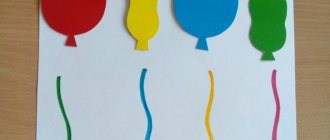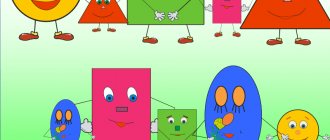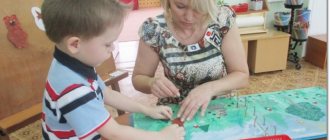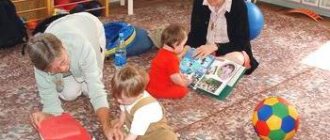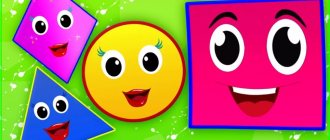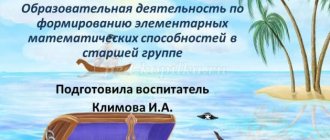Innovative experience of teacher Oksana Aleksandrovna Pankova
Innovative pedagogical experience of the teacher MBDOU "Bulgakov kindergarten" Teremok "Kochkurovsky municipal district of the Republic of Mordovia Oksana Aleksandrovna Pankova Topic: "Development of mathematical concepts of preschool children through didactic games and exercises."
2. Conditions for the formation of experience 3. Theoretical basis of experience 4. Relevance and prospects of experience 5. Novelty of experience 6. Targeting of experience 7. Labor intensity of experience 8. Technology of experience 9. Effectiveness of experience 10. Applications. . 2 Conditions for the formation of experience
“A game is a huge bright window through which a life-giving stream of ideas and concepts about the world around us flows into the child’s spiritual world. Play is the spark that ignites the flame of inquisitiveness and curiosity.” V.A. Sukhomlinsky Playing is the main and favorite activity of children. A child comes into the world... Adults should surround the child with love, care, attention, affection, teach him to enjoy life, to have a friendly relationship with peers and adults. Adults lead the child along the path of understanding the world in all its diversity and realizing oneself in this world, playing with the child, and later creating all the conditions for his independent play. All famous teachers and scientists used games and emphasized their huge role in the upbringing and teaching of children. This is A.I. Sorokina, A.P. Usova, L.A. Wenger and others. Famous teacher and researcher A.V. Zaporozhets appreciated the role of the didactic game. He wrote: “We need to ensure that didactic play is not only a form of assimilation of individual knowledge and skills, but also contributes to the overall development of the child.” The material is better absorbed by children if it is presented in a playful form, therefore classes on the formation of elementary mathematical concepts in children are carried out in the form of a didactic game or as part of a lesson. Using didactic games on FEMP, we solve a number of problems: - compare objects with each other. — instill the skills of classifying objects by shape, color, size. - develop memory, fine motor skills, logical thinking, attention. - give definitions to certain concepts. - develop resourcefulness and intelligence, intellectual abilities. Thus, didactic games and exercises are an effective means of developing EMT in preschool children. But only if you use it in an entertaining, engaging way. After all, when playing, a child experiences great joy, and in conditions of joy, development proceeds more intensively and successfully. On this problem, I selected methodological literature: 1. T.A. Pavlova “Development of spatial orientation.” 2. V. Volina “Learning by playing.” 3. D.V. Mendzheritskaya "To the teacher about children's play." 4. I.V. Skvortsov "One Hundred Logic Games". 5. A.A. Wenger "Games and exercises to develop children's mental abilities." 6. I.A. Sorokina “Didactic games in kindergarten”. 7. L.V. Mikhailov "Mathematics is interesting." 8. L.A. Obromyan "Preschooler's Game". 9. Kasabutsky “Let’s play.” 10. N.V. Babkin "Educational games with elements of logic." Articles in specialized magazines, for example in “Preschool Education”, “Hoop”. Methods and techniques: practical, game, experimentation, modeling. Didactic technologies: visual material, books, computer, Dienesh logic blocks, Cuisenaire colored counting sticks, plane modeling games (Pythagoras, Tangram), puzzle games, tasks - jokes, crosswords, rebuses. Thus, by playing and studying with children, the teacher contributes to the development of their skills and abilities - to operate with the properties, relationships of objects, to identify the simplest changes and dependencies of objects in shape, size, to compare and generalize groups of objects, to strive and show initiative and independence. 3 Theoretical basis of experience
Didactic games, as a unique learning tool that meets the child’s characteristics, are included in all preschool education systems. A didactic game contains great opportunities in that children solve mental problems presented to them in an entertaining way, find solutions themselves, while overcoming certain difficulties. The child perceives a mental task as a practical, playful one, this increases his mental activity. The successful formation of elementary mathematical concepts in children is possible under the conditions of a purposeful pedagogical process, which is based on the following principles. Let's list them. • The principle of interdisciplinary communication - the formation of elementary mathematical concepts in children is carried out taking into account the content of all sections for mastering mathematical concepts: sensory education (color, shape, size), the formation of spatial concepts. • The principle of systematicity and consistency - provides for the interconnection of ideas formed in children, a consistent transition from one knowledge to another, from simple to more complex knowledge, from firmly acquired knowledge to something new. The logic of forming mathematical knowledge, establishing a connection between acquired life experience and mathematical concepts is provided. The learning process is carried out in accordance with a certain plan in stages, while a connection is established between each previous stage and the next one. • The principle of the active approach – it is assumed to take into account the peculiarities of the structure of children’s activities, represented by the following components: motivational-target, operational, evaluative-control. In the learning process, much attention should be paid to maintaining interest in performing practical actions, organizing and monitoring the activities of children by an adult, and forming purposeful activities. This is achieved through the use of clarity, practical actions, game techniques, and game situations that are significant for the child. • The principle of activity – presupposes a high degree of independence and initiative in the child. • The principle of logical thinking – the formation of skills in working with objects from plane figures, learning to analyze, compare, and draw conclusions in achieving the set goal. • The principle of visibility – designed to connect visual perception with thinking. It promotes targeted interaction on the functions of sensory systems involved in logical development. Visualization makes it easier to complete didactic tasks and exercises, develops interest in mathematical exercises, and accelerates the formation of mathematical concepts. All principles of education and training are implemented in unity. The importance of didactic games for the mental education of children is very great. In playing with toys and various objects, the child accumulates sensory experience. By breaking and folding a matryoshka doll and matching paired pictures, he learns to distinguish and name the size, color, shape and other characteristics of objects. The development of a child in didactic play occurs in inextricable connection with the development of his logical thinking and the ability to express his thoughts in words. To solve a game problem, you need to compare the characteristics of objects, establish similarities and differences, generalize, and draw conclusions. Thus, the ability to make judgments, inferences, and the ability to apply one’s knowledge in different conditions develops. This may be the case if the child has specific knowledge about the objects and phenomena that make up the games. Exciting didactic games create interest in solving mental problems in preschoolers: the successful result of mental effort and overcoming difficulties brings them satisfaction. Passion for the game increases the ability for voluntary attention, sharpens observation, and helps quick and lasting memorization. Everything makes didactic games an important means of preparing children for school. Mental education in the game is closely related to moral education. Solving a didactic problem always serves as an exercise of will. Following the rules of the game requires children to have restraint, self-control, and discipline. The content of didactic games helps the formation of moral ideas and concepts. Games with didactic toys, pictures, and natural materials, while promoting the accumulation of sensory experience, at the same time help the aesthetic education of children. Having learned to distinguish colors and shapes, children begin to notice the beauty in their combination and arrangement. From understanding the meaning of didactic games, the following requirements for them follow: 1. Each didactic game should provide exercises useful for the mental development of children and their upbringing. 2. In a didactic game, there must be an exciting task, the solution of which requires mental effort and overcoming some difficulties. The didactic game, like any other, includes the words of A.S. Makarenko: “Playing without effort, playing without active activity is always a bad game.” 3. Didacticism in the game should be combined with entertainment, jokes, and humor. Passion for the game mobilizes mental activity and makes it easier to complete the task.4 . Relevance and prospects of experience
The relevance of this topic is due to the fact that preschool children show spontaneous interest in mathematical categories: size, quantity, shape, time, space, which help them better navigate situations, organize and connect them with each other, contribute to the formation of concepts, and expand children’s knowledge . However, familiarization with the content of these concepts and the formation of elementary mathematical concepts is not always systematic.
Since play is the leading activity of preschool children, I included didactic games and exercises in my work. Thanks to the didactic game, children solve mental problems proposed to them in an entertaining way. All of the above convinced me of the need to include didactic games and exercises in the development of mathematical concepts and served as the basis for choosing the topic: “Development of mathematical concepts in preschool children through didactic games and exercises.” In order to develop mathematical concepts in children, didactic games and exercises for logical thinking, attention, and memory were taken as a basis. 5. Novelty of experience
Researching the literature on didactic games and exercises, I came to the conclusion that this method is new in modern pedagogy. The scientific novelty of the experiment lies in the fact that in my work I offer a detailed study, which helps to increase the level of elementary mathematical concepts of preschool children in accordance with modern requirements. A distinctive feature of didactic games and exercises is that these games and exercises are based on the child’s awareness of his activities. When performing mathematical exercises, it is proposed to actively include such functions as attention, memory, and thinking in this process. Researching the literature on didactic games and exercises, I came to the conclusion that it is impossible to do without didactic aids. They help the child calculate the analyzed object, see it in all its diversity of properties, establish connections and dependencies, determine elementary relationships, similarities and differences. Didactic aids that perform similar functions include Dienesh's logic blocks and Cuisenaire's colored counting sticks. Visual material, books, a computer, plane didactic games (Pythagoras, Tangram), puzzle games, joke problems, puzzles, didactic games of a sensory-modeling nature help solve the mental abilities of children. 6. Targeting of experience
This pedagogical experience is intended for preschool teachers with different levels of teaching skills, working with creative interest. The presented experience is aimed at preschool teachers, preschool children and their parents, since only through mutual understanding and joint activities can positive work results be achieved. The presented experience meets the criteria of advanced pedagogical experience, since it is characterized by relevance, effectiveness, optimality, stability, and scientific character. So, entertaining mathematics as a means of developing logical thinking, contributes to the comprehensive development of the child, namely: the development of mental and creative abilities, cognitive interest, speech, imagination, memory, perception, communication skills, forms moral and volitional qualities, and is one of the effective means of preparing children for school.
7. Labor-intensiveness of the experiment The difficulties in implementing this experiment are that the teacher himself must master mathematical abilities well, only then begin teaching preschoolers. The condition for such training and education is the organization of interconnected scientific, moral, legal, aesthetic and practical activities of preschoolers, aimed at studying and improving mathematical abilities. The difficulty in implementing this experience is that it is necessary to produce a lot of visual handouts, select and analyze didactic games and exercises. It is necessary that the teacher himself has good knowledge in the field of didactic games. 8. Technology of experience. An important place is given to teaching children the basics of mathematics. This is caused by a number of reasons: the abundance of information received by the child, increased attention to computerization, the desire to make the learning process more intense, the desire of parents to teach the child to recognize numbers, count, and solve problems as early as possible. The main goal is being pursued: to raise children as people who can think, navigate well in everything that surrounds them, correctly assess the various situations they encounter, and make independent decisions. The main effort of both teachers and parents should be aimed at instilling in the child the need to be interested in the process of learning itself, in overcoming the difficulties that stand in this way, in independently searching for solutions, in achieving the goal. I work according to the program of E.V. Kolesnikova: “Mathematical steps”. The tasks are grouped into the following sections: 1. Quantity and counting 2. Geometric figures 3. Magnitude 4. Orientation in time 5. Orientation in space 6. Logical tasks The tasks of the section “Quantity and counting” are to develop independence, activity, introduce counting within 10, practice composing and solving simple addition and subtraction problems, consolidate understanding of the relationships between numbers in the natural series, develop mental processes: attention, memory, logical forms of thinking. To achieve this goal, I use the following games: - “Name the next, previous number”; - “Name the neighbors of the number”; - “Name more by 1, less by 1”; — “Up, down numerically”; - “Make up and solve a problem.” These games help improve skills, consolidate understanding of the relationships between numbers in the natural series, form a sustainable interest in mathematical knowledge, develop attention, memory, and logical forms of thinking. In the “Geometric Figures” section, I consolidate ideas about polygons and their properties, develop the ability to classify geometric figures according to certain characteristics, visual-spatial perception, and logical thinking. In my work I use games that help implement the tasks of the section: - “Name objects of a given shape”; - “What do the figures have in common and how do they differ”; - “Find objects of the same shape”; — “Select items by color, size and shape”; — “Find the extra figure”; — “Constructor”; - “Fix the blanket”; - “Tangram”. Thus, the work carried out helps to consolidate the child’s knowledge about geometric figures and their properties, develops the ability to classify them according to individual characteristics and perform logical operations with them, and develops logical thinking. The next section is “Determination of magnitude”. The objectives of this section are to develop the ability to compare mass, volume, quantity of liquid, granular and solid bodies, compare the results obtained, and draw conclusions. In my work on this section I use experimental games: - “Which vessel has more water?”; - “Which is easier, which is heavier?”; - “What sinks, what floats”; - “Pick up a scarf for the dolls”; - “Shorter is longer”; - “Choose furniture for three bears.” In games, children have the opportunity to independently compare the mass, volume, quantity of liquid, granular and solid bodies in a practical way, compare the results obtained, and draw conclusions. Games develop memory, attention, eye, and improve mental activity. In the “Time Orientation” section, I develop a sense of time, teach how to tell time using a clock, get acquainted with different types of clocks: water, sand, mechanical, and reinforce children’s ideas about the sequence of days of the week and the month of the year. In my work I use the following didactic games: - “Yesterday, today, tomorrow”; - "Days of the week"; — “My daily routine by the hour”; - “Get the time by the clock”; - “When does this happen?”; - “What did the artist mix up?” The games used contribute to the development of children's orientation in time: the sequence of days of the week, parts of the day, months of the year; I improve children’s understanding of the daily routine, develop a sense of time, and the ability to determine time by a clock. I especially highlight logical problems. They develop in children methods of mental activity (analysis, synthesis, comparison, classification, generalization). I use the manual (“Vietnamese Game”, “Magic Circle”, “Columbus Egg”, “Tangram”, “Mongolian Game”, puzzles, crosswords, problems in verse). These games develop children's independence, activity, voluntary attention and logical thinking. By organizing classes based on the interests, needs and inclinations of children, thereby stimulating the children’s desire to engage in mathematics. Based on the results of diagnostics carried out at the beginning of the school year, I select those children who have problems in the main areas of mathematical development and do individual work. The peculiarities of this work are that this activity represents a system of exciting games and exercises for children with numbers, signs, geometric shapes, thereby allowing them to qualitatively prepare children for school. Ingenuity, puzzles, and entertaining games arouse great interest among the children. Children can, without distraction, practice transforming figures for a long time, rearranging sticks or other objects according to a given pattern, according to their own ideas. Children develop important personality traits: independence, observation, resourcefulness, intelligence, perseverance, and constructive skills. In the course of solving ingenuity problems and puzzles, children learn to plan their actions, think about them, guess in search of a result, while showing creativity. This work activates not only the child’s mental activity, but also develops in him the qualities necessary for professional excellence, no matter in what field he later works.
9. Effectiveness of experience The formation of mathematical abilities in preschoolers should be carried out in a system, using the impressions from the classes themselves and involving: various didactic games. The concept of “development of mathematical abilities” is quite complex, comprehensive and multifaceted. It consists of interrelated and interdependent ideas about space, form, size, time, quantity, their properties and relationships, which are necessary for the formation of “everyday” and “scientific” concepts in a child. At the same time, there are practically no special studies in the field of development of mathematical abilities of children of preschool and primary school age. At the same time, the concept of “mathematical development” was considered only in the last two studies, where it is understood as the formation of mathematical knowledge and skills in a child. Thus, even within the framework of research on the development of cognitive abilities and creative talent in young children, little attention has been paid to the child’s mathematical development. At the same time, the concept of “mathematical development” is interpreted mainly as the formation and accumulation of mathematical knowledge and skills. The mathematical development of preschoolers refers to qualitative changes in the child’s cognitive activity that occur as a result of the formation of elementary mathematical concepts and related logical operations. Mathematical development is a significant component in the formation of a child’s “picture of the world.” The formation of a child’s mathematical concepts is facilitated by the use of a variety of didactic games. In the game, the child acquires new knowledge, skills and abilities. Games that promote the development of perception, attention, memory, thinking, and the development of creative abilities are aimed at the mental development of the preschooler as a whole. The mathematical development of a preschooler is a process of qualitative change in the intellectual sphere of the individual, which occurs as a result of the child’s formation of mathematical ideas and concepts. Thus, mathematical development is seen as a consequence of learning mathematical knowledge. To some extent, this is certainly observed in some cases, but it does not always happen. If this approach to the mathematical development of a child were correct, then it would be enough to select the range of knowledge imparted to the child and select the appropriate teaching method “for it” in order to make this process really productive, i.e. result in “universal” high mathematical development in all children.
Children love to play with puzzles and counting sticks. If children have difficulty solving problems, then funny problems and joke problems help them with this and children solve them quickly and with enthusiasm. They remembered the numbers faster, having memorized funny poems, counting rhymes, and riddles. Working with visual models not only helps children learn to analyze, compare, and generalize, but also significantly enriches their speech; By analyzing new material and graphically designating it, the child (under the guidance of adults) learns independence, perseverance, and visually perceives the plan of his actions. His sense of interest and responsibility increases, he becomes satisfied with the results of his work, and mental processes such as memory, attention, and thinking improve, which has a positive effect on his intellectual development and is one of the good indicators of a child’s readiness for school.
Experience as a senior kindergarten teacher. Integration of FEMP in different educational areas
Integration of the formation of elementary mathematical representations (FEMP)
in different educational areas (slide 1) Mathematics is one of the most difficult subjects in school. Preschoolers don’t know about this yet and shouldn’t find out. Therefore, our task is to give the child the opportunity to feel that he can understand and master not only specific concepts, but also general patterns. And the most important thing is to know the joy of overcoming difficulties. A distinctive feature of modern pedagogy is its focus on the future. Nowadays, not only new methods of studying mathematics have appeared, but mathematics itself is a powerful factor in the development of a child, the formation of his cognitive and creative abilities. (slide 2) Integration (according to Ozhegov) - parts of one whole. The integrated approach corresponds to one of the principles of preschool didactics: education should be small in volume, but capacious.
Reforming the preschool education system in connection with the adoption (FSES DO) of the federal state educational standard for preschool education involves revising the content, methods and forms of work with children established in theory and practice. In the new conditions, it is necessary to use flexible models and technologies of the educational process, which involve the activation of independent actions of children and their creative manifestations, a humane, dialogical style of communication between the teacher and the child. (slide 3) Integrated classes are not an innovation, but a well-forgotten old and familiar, especially for experienced teachers. After all, the term “integrated” classes appeared back in 1973, but this issue was not sufficiently developed at that time. (slide 4) According to the Federal State Educational Standard for Educational Education, the program should be based on the principle of integration of educational areas: (slide) - social and communicative development, - cognitive development, - speech development, - artistic and aesthetic development, - physical development in accordance with their specifics and age possibilities of pupils. (slide 5)
(FEMP) The formation of elementary mathematical concepts in preschoolers is included in the educational area “Cognitive Development” and is aimed at obtaining primary (slide 6) ideas about the properties and relationships of objects in the surrounding world (about shape, color, size, quantity, number, part and whole, space and time). (slide 7) It is during the acquisition of mathematical concepts that the child receives a sufficiently sensory experience of orientation in the various (slide) properties of objects and the relationships between them, masters the techniques and methods of cognition, applies the knowledge and skills formed during training in practice. (slide 9) Integration of mental and physical activity can be carried out in the process of filling physical education activities with mathematical content.(slide 10) During the direct educational activities in physical education, children encounter mathematical relationships: compare an object in size and shape or determine (slide 11) where left side, and where is the right. In classes, we use various flat and three-dimensional geometric figures and numbers. (slide 12-2p) A lot of work is done on orientation in space and relative to one’s body. When consolidating quantitative calculation, students perform various exercises: (slide 13 ) “Jump on one leg”, “Jump 10 times on the left leg, 10 times on the right”, (slide 14) “Occupy a house of a certain color or shape”). Children, without realizing the load, count, reflect, think. (slide 15)
(slide 7) It is during the acquisition of mathematical concepts that the child receives a sufficiently sensory experience of orientation in the various (slide) properties of objects and the relationships between them, masters the techniques and methods of cognition, applies the knowledge and skills formed during training in practice. (slide 9) Integration of mental and physical activity can be carried out in the process of filling physical education activities with mathematical content.(slide 10) During the direct educational activities in physical education, children encounter mathematical relationships: compare an object in size and shape or determine (slide 11) where left side, and where is the right. In classes, we use various flat and three-dimensional geometric figures and numbers. (slide 12-2p) A lot of work is done on orientation in space and relative to one’s body. When consolidating quantitative calculation, students perform various exercises: (slide 13 ) “Jump on one leg”, “Jump 10 times on the left leg, 10 times on the right”, (slide 14) “Occupy a house of a certain color or shape”). Children, without realizing the load, count, reflect, think. (slide 15)
(FEMP) Formation of elementary mathematical concepts (slide 18) is directly related to the educational area “Speech development”, where the main task is the development of mathematical vocabulary in children. (slide 19 - 2p) During the integration process, children practically master lexical and grammatical categories and practice correct sound pronunciation. (slide 20) The process of forming a mathematical vocabulary involves systematic assimilation and its gradual expansion. Thus, qualitative relationships (slide 21) should be recognized in practical actions comparing aggregates and individual objects; In classes, children learn not only to recognize the size of objects, but also to correctly reflect their ideas; (slide 23) distinguish changes in total volume; find more complex orientations in the size of objects (slide 24); master nouns denoting objects, geometric figures (slide 25) as well as spatial relationships and temporal designations. (slide 26) Familiarization with literary works and small forms of folklore contributes to the child’s formation of ideas about the characteristics of various properties and relationships that exist in the natural and social world; (slide 27) this develops the child’s thinking and imagination, enriches emotions, and provides examples of the living Russian language. Many works contribute to the formation of ideas about quantitative relationships, parts of the day, days of the week, seasons, size and orientation in space. (slide 28) While reading fiction and writing short stories, we paid attention to the number of parts of a particular work. (slide 29) In any of the fairy tales, be it folk or original, there are a number of mathematical concepts. The fairy tale “Kolobok”, “Teremok”, “Turnip”, “Winter Move” and “Telephone” introduces quantitative and ordinal counting, and even the basics of arithmetic operations. (slide 30) You can also widely use such small folklore forms as proverbs, sayings, nursery rhymes, jokes, counting rhymes and, of course, riddles. (slide 31) Mathematics penetrates into “Artistic and Aesthetic Development” and helps solve problems through its methods and techniques. Visual, (slide 32) tactile landmarks will help children remember in more detail and experience certain mathematical concepts (slide 33) (slide 34) We pay attention to how many parts and what size a piece of plasticine or a strip of paper needs to be divided. (slide 35) How can you get an object of one form or another, fixing not only the color, (slide 36) shape, size of the object, but also its spatial location. (slide 37) When drawing plants, nature, (slide 38-2p) we note the location of objects, count how many parts and where, you need to depict the object (slide 39), (slide 40) (slide 41-2p) In music classes we use musically - didactic games to develop a sense of rhythm, which contribute to the development and consolidation of some mathematical definitions. Children learn that sounds can be long and short, high and low (slide 42-2p) Musical outdoor games help consolidate knowledge of the color and shape of an object. The skill of orientation in space is also strengthened.
Thus, elementary mathematical concepts in preschoolers are acquired, consolidated and developed through musical material. (slide 43) Mastering mathematical concepts continues in everyday life. While on duty, children name how many dishes are missing on the tables, how many children the tables are set for today, etc. (slide 44) During walks, the children and I noted the current day, month, season. (slide 45) We consider objects of living, inanimate nature, name the color, shape, size of an object or object. (slide 46) (Find the tallest or shortest plant on the site, etc.). In independent activities, children use “Nikitin cubes”, “Geokont”, various mosaics, puzzles, didactic games (slide 47). When introducing children to scales, we introduce (slide 48) to measuring the mass of an object. We tell you what kinds of hours there are: (slide 49-2p) (slide 50) Integration made it possible to combine together all types of activities (slide 51) of a child in kindergarten, one topic flows from one educational area to another, (slide 52-2p) and in each their teaching, reinforcing and educational tasks are solved. (slide 53) Practice shows that older preschoolers show increased cognitive interest in classes only when (slide 54) they are intrigued and amazed by something unknown to them. In this case, the information looks interesting, almost magical, in their eyes. (slide 55) The teacher’s task is to make classes on the formation of elementary mathematical concepts entertaining and unusual. (slide 56-2p) (slide 57) The age of computerization is boldly sweeping across the country, so we introduce (slide 58-2p) new technologies into our work and use multimedia equipment as visual material. (slide 59-2р) From this we can conclude that integration deeply restructures the content of education, leads to changes in working methods and creates conditions and new teaching technologies. It also provides a completely new psychological climate for the child and teacher during the learning process. (slide 60)
We recommend watching:
Preschool teacher in raising children Sample analytical report on the results of monitoring in a preschool educational institution according to the Federal State Educational Standard Analytical report on the results of diagnosing the physical development and emotional sphere of preschools Work experience of a senior kindergarten teacher in methodological work
Similar articles:
Surprising moments in kindergarten classes. Card index
Kindergarten teacher business card
Presentation of kindergarten for parents
Morning exercises in kindergarten in the preparatory group
Features of outdoor games with preschool children
